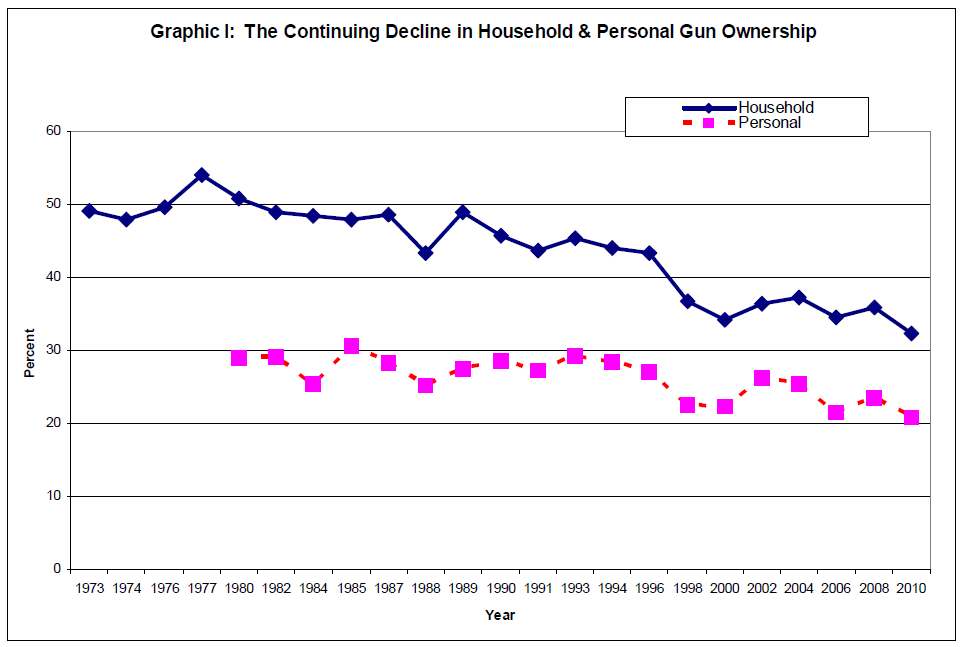Household gun ownership has continued its decades-long decline, hitting a new low in 2010 according to new national survey data from the General Social Survey (GSS).
The GSS data is analyzed in a new Violence Policy Center report, A Shrinking Minority: The Continuing Decline of Gun Ownership in America.
The VPC has also issued a companion video to the report.

The GSS has tracked household and personal gun ownership since the early 1970s and, except for the U.S. Census, is the most frequently analyzed source of information in the social sciences.
So what is the GSS? Conducted by the National Opinion Research Center (NORC) at the University of Chicago:
The VPC has also issued a companion video to the report.

The GSS has tracked household and personal gun ownership since the early 1970s and, except for the U.S. Census, is the most frequently analyzed source of information in the social sciences.
So what is the GSS? Conducted by the National Opinion Research Center (NORC) at the University of Chicago:
The GSS is the largest project funded by the Sociology Program of the National Science Foundation. Except for the U.S. Census, the GSS is the most frequently analyzed source of information in the social sciences...It is the only survey that has tracked the opinions of Americans over an extended period of time. The GSS is also a major teaching tool. We know of over 14,000 research uses such as articles in academic journals, books, and Ph.D. dissertations based on the GSS and about 250,000 students annually who use it in their classes.
Essentially it's the gold standard of survey data.
According to the GSS data analyzed in the VPC report:
- Household gun ownership peaked in 1977, when more than half (54 percent) of American households reported having any guns. By 2010, this number had dropped more than 20 percentage points to 32.3 percent of American households reporting having any guns in the home--the lowest level ever recorded by the GSS. In 2010, fewer than a third of America households reported having a gun in the home.
- Personal gun ownership peaked in 1985, when 30.7 percent of Americans reported personally owning a gun. By 2010, this number had dropped nearly 10 percentage points to 20.8 percent--the lowest level ever recorded by the GSS. In 2010, slightly more than one out of five Americans reported personally owning a gun.
- Male gun ownership peaked in 1990, when 52.4 percent of males reported personally owning a gun. By 2010, this number had dropped more than 19 percentage points to 33.2 percent--the lowest level ever recorded by the GSS. In 2010, only one out of three American males reported personally owning a gun.
- Female gun ownership has fluctuated within a narrow range with no recent signs of increase. Relatively rare, female gun ownership peaked in 1982 at 14.3 percent. In 2010 the female personal gun ownership rate was 9.9 percent. Only one out of 10 American females reported personally owning a gun in 2010.
Looking at these numbers another way, a clear majority of American households are gun-free and most Americans do not personally own a gun.
And, despite the NRA and gun industry's decades-long efforts to market firearms to women--and the willingness of an all-too-often gullible news media to accept these claims on mere assertion, misleading statistics, and frequently unfounded claims--nine out of 10 women don't personally own a gun.
The continued decline of gun ownership is one reason why the NRA has institutionalized its efforts seeking financial support from the gun industry, receiving millions of dollars from "corporate partners" that include manufacturers and vendors of handguns, assault weapons, high-capacity ammunition magazines, and other firearm-related items. It has even received between $500,000 and $999,999 from Xe, the new name for the now-infamous Blackwater Worldwide, known for its abuses in the Iraq war.
The NRA, however, barges on, thumping its chest and acting as if the country as a whole has bought into its vision of Fortress America (unless, of course, the organization needs to raise a little extra money from its non-corporate supporters). Yet imagine if any other industry and its de facto trade association faced the future represented by the GSS numbers on gun ownership. What if the number of households with television sets, cars, or computers saw similar declines? They wouldn't try to dimiss the numbers, but would make changes in their products and their marketing to try and address the crisis. The NRA and the gun industry have attempted to follow this model--but with little success (see household and women's gun ownership figures above). As a result, their most common public response to this new reality is to deny it. In industry publications and meetings, however, the trends against gun ownership are openly acknowledged--and feared.
The bottom line is that a clear majority of Americans have no place for guns in their lives. And recognizing the factors that have led to this continued decline--the aging of the current-gun owning population and a lack of interest in guns by youth, the end of military conscription, the decreasing popularity of hunting, land-use issues that limit hunting and other shooting activities, environmental and zoning issues that force shooting ranges to close and limit new range construction, and the increase in single-parent homes headed by women--it doesn't look like most Americans are going to be changing their minds anytime soon.
http://www.huffingtonpost.com/josh-sugarmann/gun-ownership-hits-new-lo_b_854564.html?view=print
No comments:
Post a Comment